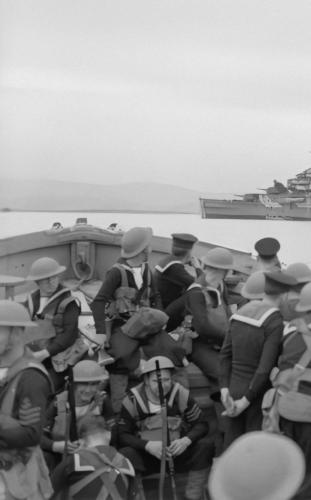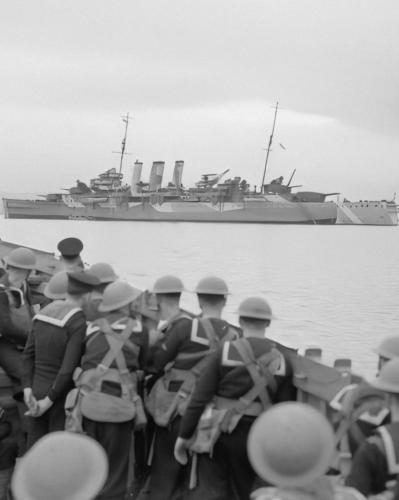
copyright © Wartime Heritage Association
Website hosting courtesy of Register.com - a web.com company
Wartime Heritage
ASSOCIATION
Remembering World War II
Name:
Thomas Hyden
Rank:
Marine
Service Number:
PLY/X 3624
Service:
HMS Gloucester (62),
Royal Marines
Date of Birth:
January 11, 1915
Place of Birth:
River Hebert East,
Cumberland Co., Nova Scotia
Date of Death:
May 22, 1941
Age:
26
Memorial:
Plymouth Naval Memorial
Reference:
Panel 59, Column 3
Thomas Hyden was the son of William Enoch Hyden and
Marion (Spencer) Hyden. His mother was born in Bloxwich,
Staffordshire, England; his father - in Staffordshire also, in
Heath Hayes. Thomas had one brother William S (born
1913), and two sisters – Marian J (born 1920), and Elizabeth
Matilda (born 1928).
Thomas’ father William served Canada in the First World
War as a Sapper with the 40th Battalion, the 123rd Pioneer
Battalion, and the 7th Canadian Engineers Battalion
(Service No. 414880) with the Canadian Expeditionary Forces
in France. His attestation papers indicate he was 5 feet, 5 and ½ inches tall, fair complexion, blue eyes and
brown hair when he enlisted. He and his wife were living in River Hebert at the time.
In 1921 Census the family was living in Chignecto Mines, Cumberland Co., Nova Scotia. Thomas’ father
worked as a coal miner.
Thomas travelled on the RMS Newfoundland
from Halifax to Liverpool, arriving in
England on May 19, 1939. There is record of
him in 1939, married and residing at 66
Elson Lane in Gosport, Hampshire, England
and employed as a stationary engineer.
The details of Thomas’ joining the Royal
Navy are unknown, but he was serving
aboard HMS Gloucester (62), a Towne-class
light cruiser, in the Mediterranean in 1941.
The HMS Gloucester was known as “The
Fighting G”.
The Battle of Crete took place from May 20-
31, 1941. With some 40000 Allied troops on
Crete, many of whom had already been
evacuated from Greece, and with limited
resources with which to mount a meaningful
defence, a German airborne assault on Crete
began on May 20, 1941. In the face of
absolute enemy superiority in the air, the
Navy did all it could, in spite of grievous
losses, to save the island from German
occupation, and when defence became no
longer possible it managed to extricate some
17000 troops from the island. Between 20 and 31 May the Mediterranean Fleet lost the cruisers Gloucester,
Calcutta, York and Fiji; the destroyers Juno, Greyhound, Kelly, Kashmir, Imperial and Hereward; one
minesweeper and 29 smaller craft. The ship was lost after repeated attacked by enemy dive-bombers and
other aircraft.
Of the 807 men aboard at the time of HMS Gloucester’s sinking, only 85 survived to reach shore; two more
subsequently died after being taken into captivity, one in 1941 and another in 1945.
Marine Thomas Hyden’s body was not recovered and he is remembered on the Plymouth Naval Memorial.
Thomas Hyden




Royal Marines aboard HMS Rodney, 1940 (© IWM A 144)
Royal Marines aboard HMS Rodney, 1940 (© IWM A 144)


- World War I - Menu
- WWI Stories and Articles
- Photos - Yarmouth Soldiers
- Selection of World War I Songs
- WWI Casualties of Yarmouth, NS
- Those Who Served - Yarmouth, NS
- WWI Casualties Digby Co. NS
- WWI Casualties Shelburne Co. NS
- Merchant Mariners (1915) Yarmouth, NS
- Canadian Forestry Corps - Non Yarmouth Birth/Residence Enlistments
- US Draft Registry - Yarmouth NS Born


- World War II - Menu
- WWII Stories and Articles
- Telegraphist Air Gunners
- WWII Casualties of Nova Scotia
- US Casualties with NS Connection
- Far East/Pacific Casualties with NS Connection
- Merchant Navy Casualties Nova Scotia
- Nova Scotia WWII Casualties Holten Canadian War Cemetery
- D-Day Casualties - Nova Scotia
- CANLOAN Program Casualties - Nova Scotia
- Battle of the Bulge Casualties - Nova Scotia
- WWII Casualties Yarmouth NS
- Yarmouth Casualties - RCAF RAF Canadian Army WWII
- Yarmouth Co., Marriages WWII
- Casualties Non-Born/Residents with Connection to Yarmouth Co., Nova Scotia.
- WWII Casualties Digby Co., NS
- Non-Nova Scotian WWII Casualties Buried in Nova Scotia
- WWII RCAF Casualties Aged 16-18
- Brothers/Sisters Who Served - World War II













